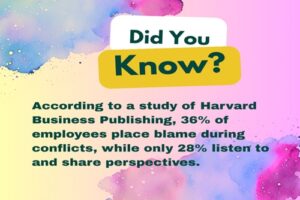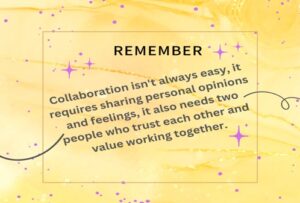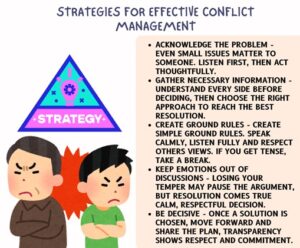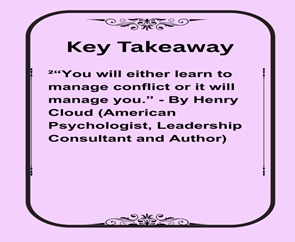Introduction
A conflict is a condition in which unacceptable differences in interests, expectations, values, or opinions occur between individuals, or between or in groups.
Why Conflict Management matters
Low morale, decreased production, and increased turnover might result from unresolved dispute. But organizations that embrace and see conflict as an opportunity, options to weigh solutions, result in positive things like found creativity and developed problems.
For example – two team members of a marketing team who have differing opinions about the design of a campaign, rather than keep their mouths shut they speak, combine their perspectives, combine their strengths and create a campaign that far exceeds expectations.

This is the real power of managing conflict well. Conflict not only lessens arguments but also fosters innovation improves outcomes, and fortifies bonds with others.

In order for people to feel comfortable talking and listening, there is a greater need for a culture that is respectful and open to discussion.
- Understanding Conflict Styles
According to the Thomas-Kilmann Conflict Mode Instrument, individuals typically approach conflict in one of five ways:
- Competing – Prioritizing one’s own goals over the other party’s concerns.This strategy works well when you are in a commanding position and have limited time and resources to resolve the conflict.
Competing is not always bad. If you think about it, competing helps us to achieve our goals.
However, this strategy has some drawbacks :
- Competing can often result in negative emotions such as anger, frustration, aggression and hostility.
- It won’t help you develop a good supportive relationship as you won’t be listening to anything the other party has to say.
- It can lead to losing opportunities as the other party won’t want to do anything with you.
Collaborating – Working together to create a solution that completely satisfies all of the parties concerns. It’s an ideal choice if both parties are committed to reaching a mutual agreement. The goal here is to reach an agreement with each other.

Compromising – Finding a quick, mutually acceptable solution by moderately satisfying others concerns. If you choose to compromise, you will find that there is a middle point between differing perspectives. This means that you mutually accepted certain items and that you surrendered other items. There is a need to be flexible, as you are trying to resolve a disagreement and a degree of flexibility is needed. This approach often leads to a win-win scenario, where each party believes that they gained something from the disagreement.
Avoiding – That means you neither asset your position nor do you consider or emphasize the other party’s point of view. You deal with the conflict by avoiding
People pick this way to settle a disagreement, when they know they can’t the other person what to do. They choose to ignore or entirely avoid the argument instead of dealing with it to avoid conflict. We often believe that steering clear of confrontation signifies weakness and submission, however, if the situation truly warrants it, it is advisable to refrain from engaging in a conflict if possible. By doing so, you will not have to confront the issue, which can lead to an improved sense of well-being.
Accommodating – When accommodating, an individual neglects his or her own concerns to satisfy the concerns of the other person, there is an element of self-sacrifice in this mode. Accommodating might take the form of selfless generosity or charity, obeying another person’s order when you would prefer not to, or yielding to another’s point of view. The idea behind this approach is to make concessions.
For example, if one person makes a request, you agree to do what the first person requested instead of arguing about the matter. It’s an effective way to manage conflict when you lack power. But be careful by making concessions, you may start to lose control over your own agenda. Determining whether relinquishing to a conflict is worthwhile calls for an assessment of the pros and cons prior to making a decision. If a person could effectively use all of the Thomas-Kilmann Conflict Mode Instrument approaches i.e. avoiding, competing, accommodating, compromising, and collaborating, they would be an incredibly adaptable and skilled conflict resolver, able to select the most effective strategy for any given situation.

Preventing Conflicts Proactively
It is important to also stop conflicts as much as it is to resolve them. Open communication, clear expectations, mutual trust, and emotional intelligence education can help you stop conflicts before they occur.
Conclusion
If managed well,conflict becomes a bridge to growth. It transforms disagreements into cooperation and creativity when there is open communication,a solid understanding of conflict types conflict intelligence.






Leave a Reply